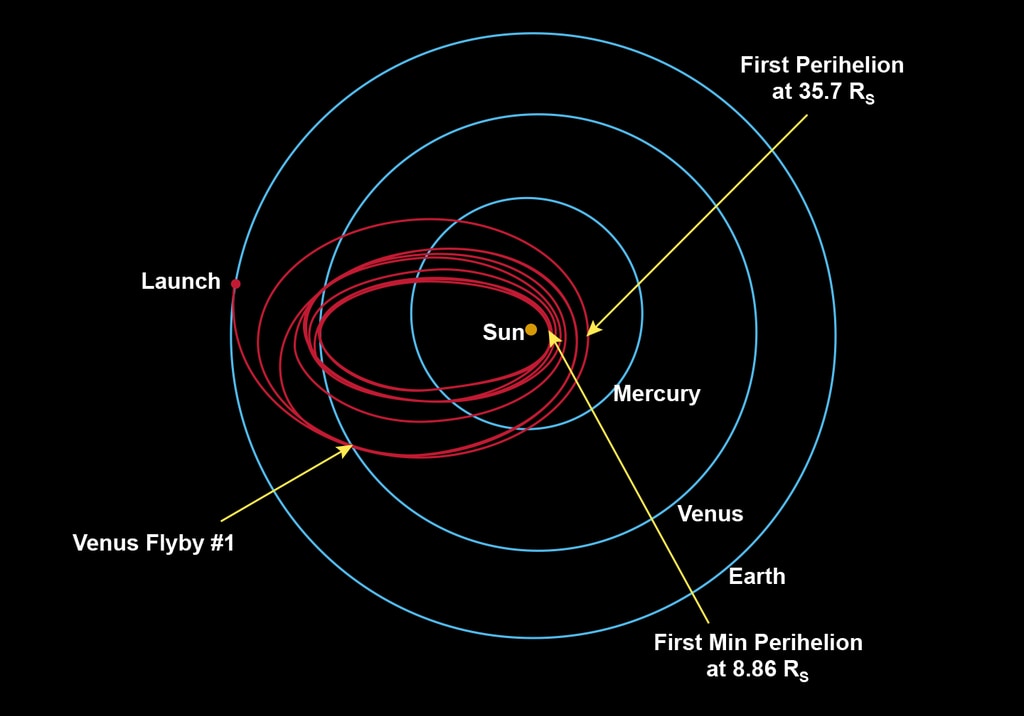The Parker probe needs to lose a great deal of orbital energy and angular momentum in order to approach the Sun so closely. It will be aided in doing that by multiple flybys of Venus. Are these purely "gravitational slingshot" maneuvers, or will they actually graze the upper atmosphere of Venus and lose energy that way? If not, why not? The idea seems intuitively appealing.
-
2$\begingroup$ That's "lose". I know, English is stupid. $\endgroup$– Monty HarderCommented Nov 29, 2018 at 16:19
-
1$\begingroup$ @MontyHarder unless it's in the opposite direction, then you loose the probe like you loose an stone from a slingshot. Losing the probe isn't recommended though. $\endgroup$– John DvorakCommented Nov 29, 2018 at 16:37
-
$\begingroup$ I would also argue that loosening an orbit could mean increasing the periapsis. $\endgroup$– John DvorakCommented Nov 29, 2018 at 16:37
-
$\begingroup$ That works out to be aero-acceleration. $\endgroup$– JoshuaCommented Nov 29, 2018 at 17:28
-
$\begingroup$ Aerobraking loses velocity with respect to Venus but the probe isn't trying to be captured by Venus. It needs to lose velocity with respect to the sun, which means being redirected in the solar retrograde direction with as high a velocity as possible. $\endgroup$– Eric LippertCommented Nov 29, 2018 at 18:38
2 Answers
It's using the gravity of Venus alone. Skimming the atmosphere would risk damaging the spacecraft
From the NASA blog
On Oct. 3, Parker Solar Probe successfully completed its flyby of Venus at a distance of about 1,500 miles during the first Venus gravity assist of the mission. These gravity assists will help the spacecraft tighten its orbit closer and closer to the Sun over the course of the mission.
Detailed data from the flyby will be assessed over the next few days. This data allows the flight operations team to prepare for the remaining six Venus gravity assists which will occur over the course of the seven-year mission.
-
$\begingroup$ Any more details or sources for the risk to the spacecraft? Obviously going in too deep would be bad, but given they have an incredibly tough heatshield anyway, it's not obvious why a bit of aerobraking would be so risky. $\endgroup$ Commented Nov 29, 2018 at 14:30
-
4$\begingroup$ The Parker heat shield is meant to stop the radiant heat from the sun. My bet is that it can't take the friction heat from skimming the Venus atmosphere. Remember, it's going to interface with Venus 6 times. That could wear the shield down, and it needs it to come close to the Sun. $\endgroup$ Commented Nov 29, 2018 at 15:01
-
$\begingroup$ Indeed - There's no reason to build it for atmospheric contact and add all that extra mass when the primary mission already demands lots of deadweight just for survival. Plus the additional risks of interacting with an atmosphere we don't know so much about. $\endgroup$– SaibooguCommented Nov 29, 2018 at 15:48
-
1$\begingroup$ Man, 1,500 miles is close. $\endgroup$ Commented Nov 29, 2018 at 17:12
@Machavity's answer is correct. This is just some addition, interesting data.
I had downloaded the data for Parker Solar Probe from Horizons before the launch. They had state vectors for a complete (planned) mission there (Revised: Aug 24, 2018) from launch until 2025-Aug-31 09:19:00. Currently Horizons is showing a much shorter span because it is now based on the real trajectory, but this data is likely to still be available online somewhere.
I subtracted the state vectors of Parker from Venus an the Sun, and calculated the distance. Only the last approach is close (in late 2024) and it is very close. With the 6 minute cadence that I downloaded, the minimum approach is 6753 km from the center of Venus. With a radius of Venus of 6052 km, that's really close, and the minimum distance in that simulation could be even closer! The exact numbers don't matter so much, but it certainly looks like a close approach is being contemplated here to get very close to the Sun
The first plot is not zoomed in distance, it shows the distance from Parker to the Sun and to Venus.
The second one is distance to Venus, and the last one is pretty close!
The last one is distance to the Sun, and you can see the distance takes a step closer each time it passes Venus, including that last really close one.
I'll come back tomorrow to add the calculation if nobody else does, but the delta-v changes here are huge, and drag in the atmosphere does not come within orders of magnitude of being enough to change the distance to the Sun by this much. They will get as close as they can perhaps, for the gravity, but not for the atmosphere.
-
3$\begingroup$ +1 Great data-based answer! I think it's worth noting how aerobraking compares to gravity assists in terms of their vectors. Sure, aerobraking can slow you down a lot if you can handle the heat, but it only slows you down relative to Venus. Gravity assists, on the other hand, leave you with the same relative speed to Venus, but change it relative to the Sun, which is what we want in Parker's case $\endgroup$– JackCommented Nov 29, 2018 at 16:03
-
1$\begingroup$ @Jack if possible can you write that up as another answer? It's really important but I'm swamped and can put much time into writing right now. $\endgroup$– uhohCommented Nov 29, 2018 at 16:10

